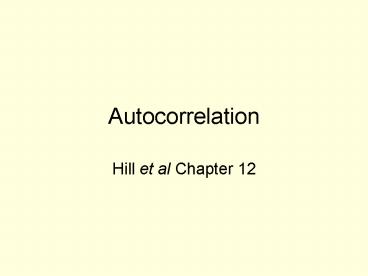Autocorrelation PowerPoint PPT Presentation
Title: Autocorrelation
1
Autocorrelation
- Hill et al Chapter 12
2
The nature of the problem
- Time series data
- Observations follow a natural ordering through
time. - Autocorrelation
- The error term contains a carryover from previous
shocks. - Related to, or correlated with, the effects of
the earlier shocks.
3
Violation of assumption MR4
4
Area response for sugar cane
5
Least squares estimation
6
First order autoregressive AR(1) errors
7
Properties of an AR(1) error
Assumption
Properties
8
Consequences of Autocorrelation
- The least squares estimator is still a linear
unbiased estimator, but it is no longer best. - The formulas for the standard errors usually
computed for the least squares estimator are no
longer correct - Hence confidence intervals and hypothesis tests
that use these standard errors may be misleading.
9
Transforming the model
10
Transforming the first observation
11
Implementing GLS
12
Sugar cane area continued
1 0.93970 -2.5868 -2.4308 3.3673 3.1642
2 0.65799 -2.1637 -1.2790 4.2627 3.1110
3 0.65799 -2.2919 -1.5519 3.7677 2.2798
4 0.65799 -2.2045 -1.4206 4.4998 3.2215
13
The Durbin-Watson test
14
Critical values for D-W
- The distribution of d under the null depends on
the values of the explanatory variables. - Critical values cannot be tabulated.
- Use software to compute appropriate p-value.
- Use the bounds test.
- Define two new stats which do not have a
distribution dependent on the data. - dL lt d lt du
15
Critical values for the bounds test
Sugar Cane Example
16
A lagrange multiplier test
17
Points to note in testing for autocorrelation
- In the LM test, the estimated residual for t1 is
missing. Either omit the first observation or
make e00. - D-W test is exact in finite samples, LM is a
large sample test. - D-W is not valid when one of the variables is a
lagged dependent variable. - The LM test can be used for higher order forms of
autocorrelation.
18
Prediction with AR(1) errors
PowerShow.com is a leading presentation sharing website. It has millions of presentations already uploaded and available with 1,000s more being uploaded by its users every day. Whatever your area of interest, here you’ll be able to find and view presentations you’ll love and possibly download. And, best of all, it is completely free and easy to use.
You might even have a presentation you’d like to share with others. If so, just upload it to PowerShow.com. We’ll convert it to an HTML5 slideshow that includes all the media types you’ve already added: audio, video, music, pictures, animations and transition effects. Then you can share it with your target audience as well as PowerShow.com’s millions of monthly visitors. And, again, it’s all free.
About the Developers
PowerShow.com is brought to you by CrystalGraphics, the award-winning developer and market-leading publisher of rich-media enhancement products for presentations. Our product offerings include millions of PowerPoint templates, diagrams, animated 3D characters and more.

